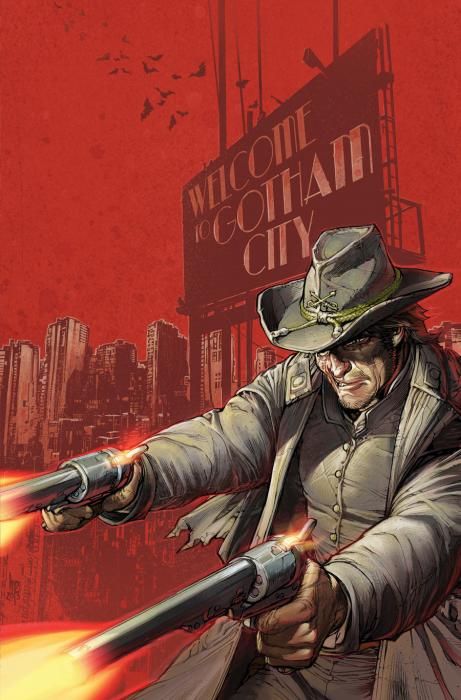Jonah Hex has ended up in modern-day Gotham: that hook should be enough to entice potential readers into taking a look at "All-Star Western" #23 by the usual creative team of Jimmy Palmiotti, Justin Gray and Moritat. The issue is far more than just a cheap and easy time time-travel gimmick. Inside readers will find plenty of insight, emotion and genuine laughs -- story elements that normally aren't found in a typical western comic.
Then, "All-Star Western" hasn't been a typical western comic. It was definitely the sole token western packaged into the New 52, and because of the genre has also been probably the most ignored and overlooked series in the whole batch. Palmiotti and Gray have told solid stories issue after issue, but have now boldly stepped it up a notch by bringing Hex into the present day.
Palmiotti and Gray shy away from the expected fish-out-of-water, deer-in-the-headlights-type of situations for Hex as he learns about this strange new world. Not everyone Hex meets thinks he's a delusional crackpot; those who get to know him see that his sincerity about his life in the 19th century gives him a believable sense of credibility, and even as these people who befriend him lavish praise on the wonders of 21st century living, Hex looks around him and sees a society that, in his eyes, is seemingly no better and perhaps even worse than the one he came from. Palmiotti and Gray take full advantage of this different backdrop and how Hex reacts to it, and in doing so are able to not only deliver a unique and fascinating story, but examine Hex's character in a manner that the usual environment wouldn't allow.
What the writers don't shy away from are current social issues and some indirect acknowledgements of recent tragic events. Upon learning of social advancements, both older and more recent, Hex's reaction is not the one many would expect and the subsequent discussion about society reveals even more about his character. It shows why Hex seems oddly comfortable in the present day, or at least no less comfortable than he is in his own time: for all of the changes and so-called advancements in the past 100-plus years, there are still wars and there are plenty of social injustices that remain. He eventually witnesses some of these ills firsthand, and feels right at home dispensing justice, Old West-style. With all of this, Palmiotti and Gray do a superb job at examining just who Jonah Hex is, and that he clearly is not the stereotypical shoot-'em-up cowboy.
A violent and disturbing sequence near the end not only exemplifies the character of Hex, but is powerful and even moving in its own right. It does everything it needs to; it shows Hex as selfless and heroic, it advances the story, and it's a thrilling climax to the best issue of this already-strong series so far. In fact, it's probably the best Jonah Hex story in recent memory.
That's to say nothing of all of the comical moments that Palmiotti and Gray throw in. One of the more subtle ones is the irony that Hex is still tooling around Gotham with a member of the Arkham family in tow, just as he repeatedly ended up doing over a century ago in previous storylines, as much as he tried to shake him. The writing team also excels at somehow knowing how to bring to life natural dialogue between a time-displaced cowboy and everyday people of this era. And artist Moritat knows how to draw a convincingly grimy, dirty, and dusty 21st century Gotham and its outskirts as well as he does the 19th.
Eschewing the title's usual backup feature, this incredibly enjoyable story has the added benefit of clocking in at a full thirty pages. While fans still eagerly await the inevitable meeting between Hex and Gotham's hometown hero, Palmiotti and Gray wisely take their time letting Hex's modern day adventures unfold. This has been one of those arcs that has just been too enjoyable to want it to end.

